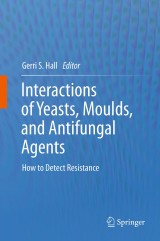Details

Interactions of Yeasts, Moulds, and Antifungal Agents
How to Detect Resistance|
96,29 € |
|
| Verlag: | Humana Press |
| Format: | |
| Veröffentl.: | 02.12.2011 |
| ISBN/EAN: | 9781597451345 |
| Sprache: | englisch |
| Anzahl Seiten: | 170 |
Dieses eBook enthält ein Wasserzeichen.
Beschreibungen
The incidence of fungal infections increases with the increase in antibiotic usage and increasing immunosuppressed populations. There is no longer only one antifungal agent and the response of fungi to various agents is not always predictable. The need for standardized antifungal susceptibility testing, and standardized interpretation of results in conjunction with studies that describe clinical outcomes based on those tools is ever important. <i>Interactions of Yeasts, Moulds, and Antifungal Agents: How to Detect Resistance</i> covers the available antifungal agents, how to perform in vitro testing and how those results should be interpreted for the most common fungal pathogens.
<p>Antifungal Agents.- Antifungal Susceptibility Testing: Clinical Laboratory and Standards Institute (CLSI) Methods.- Antifungal Susceptibility Testing Methods – Non CLSI Methods for Yeast and Moulds.- Susceptibility Testing of Dermatophytes.- Usual Susceptibility Patterns of Common Yeasts.- Usual Susceptibility Patterns of Common of Moulds and Systemic Fungi.- Usual Susceptibility Patterns for Systemic Dimorphic Fungi.- Utility of Antifungal Susceptibility Testing and Clinical Correlations.</p>
<b>Gerri S. Hall, Ph.D. </b>- The professional career has been focused on clinical microbiology: direct clinical activities of various areas such as: Bacteriology, Mycobacteria, STD testing and Antimicrobial Susceptibility Testing of bacteria and fungi. Dr. Hall’s laboratory performs clinically relevant patient care and research in these areas. She also teaches within the Department of Clinical Pathology as well as externally; and she is actively involved in developing the curriculum, for the Cleveland Clinic Foundation, Lerner School of Medicine of Case Western University.
The incidence of fungal infections increases with the increase in antibiotic usage and increasing immunosuppressed populations. There is no longer only one antifungal agent and the response of fungi to various agents is not always predictable. The need for standardized antifungal susceptibility testing, and standardized interpretation of results in conjunction with studies that describe clinical outcomes based on those tools is ever important. <i>Interactions of Yeasts, Moulds, and Antifungal Agents: How to Detect Resistance</i> covers the available antifungal agents, how to perform in vitro testing and how those results should be interpreted for the most common fungal pathogens.
References about antifungal agents and how to test for their resistance and interpret results Standardized up-to-date methods for susceptibility testing Provides a clear overview of the basics Includes supplementary material: sn.pub/extras

















